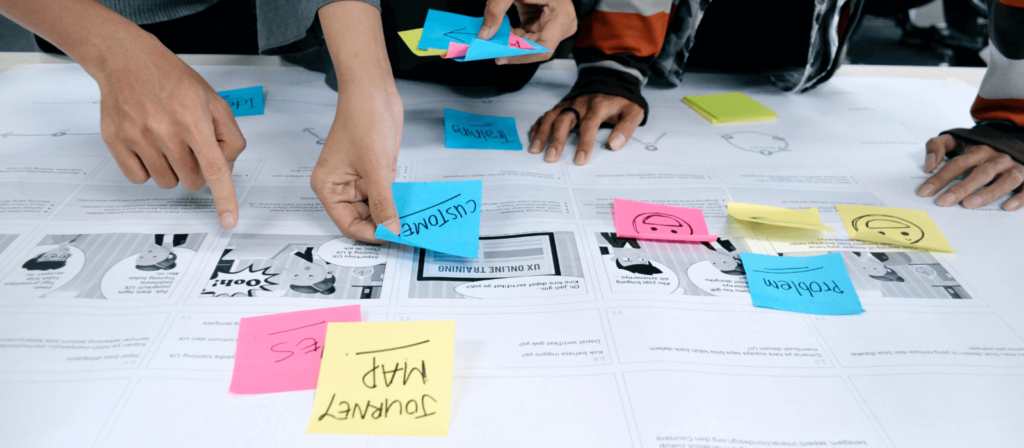Customers today are savvier and more resourceful than ever before. This is especially true in the B2B world, where sales cycles are longer and more complex than in the B2C realm.
B2B sales can feel few and far between. This problem is made worse when you use old-school approaches to generate and nurture leads. In this blog, we’ll touch on the reasons why the traditional marketing and sales funnel isn’t working any more—and what type of approach you should take instead.
The old-school way of B2B lead generation in content marketing
For nearly a century, marketers have relied on a B2B lead generation funnel built to drive leads into the sales pipeline and compel them to make a buying decision.
Here’s a classic example of how marketers try to shape their content strategy to a traditional (and mostly fictional) B2B buying process.

Meet Dani, director of sales at an enterprise company. She’s your buyer persona—your only buyer persona. In a traditional B2B marketing funnel, she’s the main decision-maker, who supposedly follows a direct customer journey that looks like this:
Experiences a problem —> learns about solutions —-> decides which solution to use —> purchases product or service
To ensure that your marketing material meets Dani along this journey, your content marketing team creates a strategy that looks like this:
1. Top of funnel
- Content: Social media, blog posts, podcasts, videos
- SEO targeting: Short-tail keywords on general, pain-aware topics (terms like “sales training ideas”)
- Distribution/promotion: Social media, SEO, content marketing
Let’s say Dani is planning a sales meeting. After searching for “sales training ideas” on Google, she clicks on a link to a listicle on your blog. A pop-up for a free “Ultimate Sales Training Guide” ebook appears, and Dani signs up for it. She has now entered . . . the funnel zone.
2. Middle of funnel
- Content: White papers, webinars, thought leadership
- SEO targeting: Long-tail keywords on specific, solution-aware topics (terms like “enterprise sales training tools”)
- Distribution/promotion: Email lists, SEO, PPC, demand generation, ad retargeting
Once Dani reads your ebook (which extols the importance of choosing the right software for remote sales management), she researches “enterprise sales training tools for remote teams.”
She receives an invite from your company to a webinar: How Our CEO Used Remote Sales Training Tools to Grow Enterprise Customer Revenue by 10x.
She signs up. Dani has converted from “lead” to “marketing-qualified lead.”
3. Bottom of funnel
- Content: Sales enablement material, case studies, proposals, product comparisons
- SEO targeting: Brand-centered keywords on product-aware topics (terms like “Gong vs. Lessonly”)
- Distribution: Account-based marketing (ABM), email outreach, blog, review sites
Your marketing team passes Dani’s contact info to the sales team for a post-webinar follow-up. Dani responds to an outreach email by scheduling a consultation. The sales rep follows up with recommendations, a case study, and a proposal.
Dani decides to sign up. Congrats! You have a new customer.
Sounds too good to be true? That’s because it is.
How does the B2B lead general funnel work in real life?
If you ask anyone involved in buying decisions with a company—even a small business—they’ll tell you that the path to a purchase is nowhere near as simple as the B2B lead generation funnel that we described.
According to HubSpot, 65% of businesses today say generating traffic and leads is their biggest marketing challenge. Nearly half of businesses (48%) say that nurturing a lead into a sale is a long cycle with many influencers.
In other words, in most B2B purchases, Dani is just one member of a group of people who take a meandering path toward a buying decision.
And, as you’ll see in a moment, that path looks nothing like a funnel.
Why B2B leads don’t turn into sales: top 4 reasons
In 2019, Gartner released a report that revealed the new reality of the B2B buying journey. The bottom line: the traditional B2B lead generation funnel reflects a buying process that no longer exists (if it ever truly did).
It ultimately serves the needs of the sales team rather than the needs of the customer, which goes against the values of customer-centered marketing.
Here are some of the hard truths that we need to face as marketers:
1. The typical buying group for a B2B solution involves six to 10 decision-makers

That’s right: Dani has at least five other coworkers and supervisors who need to be a part of the decision for her company to buy your product. Each person has four to five pieces of information they’ve gathered independently.
At some point, this group, armed with a stack of content and faced with an overwhelming amount of options, has to find a way to come to a consensus.
No wonder more than three-quarters of B2B customers describe their purchasing process as “very complex.”
2. Each stakeholder performs multiple jobs within the buying group
Gartner research identified six B2B buying “jobs.” These are the activities that customers say they need to fulfill either individually or as a group before they can finalize a purchase. In a buying group, each job isn’t exclusive to one person—a group member can perform all six jobs while another only performs one.

- Problem identification: Company experiences pain. “We need to do something.”
- Solution exploration: Buying group researches possible solutions. “What’s out there to solve our problem?”
- Requirements-building: Buying group does internal needs assessment. “What exactly do we need the purchase to do?”
- Supplier selection: Buying group evaluates products/services. “Does this do what we want it to do?”
- Validation: Buying group tests their hypothesis for how to solve the problem. “We think we know the right answer, but we need to be sure.”
- Consensus creation: Buying group seeks agreement/approval on next steps. “We need to get everyone on board.”
These jobs may resemble the phases of the traditional funnel, but keep in mind that all of this can happen simultaneously and more than once before a purchase is made.
3. B2B buying journeys don’t follow a linear path
The same Gartner report shows that the B2B buying journey is more complicated than ever. Customers loop around from stage to stage, referring back to content and sharing it with more members of the group. They seek to deconflict, build consensus, and get buy-in from one another through the entire process. The B2B sales process thereby looks less like a funnel, and more like the flight path of a hummingbird.

4. B2B buying activities aren’t performed in order of importance
A B2B buying group distributes its time pretty evenly between activities while working simultaneously. While one person may be learning more about a problem offline at a conference, another member may be meeting with potential suppliers and doing further research online.

Distribution of buying group’s time:
- Researching independently online: 27%
- Meeting with buying group: 22%
- Researching independently offline: 18%
- Meeting with potential suppliers: 17%
- Other activities: 16%
How to evolve your B2B lead generation strategy for today’s buyers
It’s time to adopt a more realistic, helpful way of meeting buyers where they shop. Here are some ways your organization can adapt to the new reality.
Get your marketing, sales, and customer success teams involved early on
Almost all (90%) buyers reported circling back to at least one step of the buying journey before making a purchase. As a result, they interact with marketing and sales multiple times before making a buying decision, and customer success isn’t introduced until they’ve agreed to a purchase.
From the customer’s perspective, getting passed like a baton from marketing to sales and then to customer success means repeating the same conversations again and again.
It also means more unwelcome surprises that can lead to uncertainty and/or churn. For example, sales may promise a capability that customer success can’t support.
Today, it’s more important than ever that your marketing, sales, and customer success teams work in tandem from beginning to end. Rather than acting like a relay team, they can approach the customer relationship as a group of advisers that guide buying groups and connect them with resources.
Customer success platform Vitally suggests introducing your customer support team early in the sales process to make buying jobs easier and to make the transfer of responsibility as seamless as possible once a deal closes.
“The fear of a complicated implementation process is a significant obstacle for some prospects to overcome,” says Kevin Fu, head of revenue at Vitally. “CSMs have been through it all and can explain to the potential customer, with firsthand knowledge, what the implementation will look like.”
Identify the buying group that you’re selling to

While Gartner reports that a committee of six to 10 participants makes larger B2B purchase decisions, Forrester’s SiriusDecisions has observed that there are different types of buying journeys, depending on the complexity of the purchase and the culture of the industry you’re targeting.

Committee
- Executive leadership makes the buying decision
- A group of six to 10 stakeholders collectively recommend a solution to executive leadership
- There are five or more roles within the buying group (e.g., initiator, gatekeeper, influencer, user, decider, and buyer)
- The purchasing time frame can take more than two quarters
Consensus
- Multiple teams, functions, or departments need to agree to a buying decision
- The buying group is three to five people from various teams/functions
- They assume three or four buying roles (e.g., initiator, decider, buyer, and user)
- The purchasing time frame is one to two quarters
Independent
- An individual makes the buying decision
- The buying group is one or two people
- They perform one or two buying roles (i.e., buyer, user)
- The purchasing time frame is eight weeks or less
Create personas of everyone in the buying group

A single persona can’t encompass the decision-making factors of six to 10 people. That’s why you’ll need to develop an accurate portrait of everyone involved in the buying process. Documenting and communicating who the true decision-makers are will increase the efficiency of your content marketing and speed up the sales cycle.
A jobs-to-be-done (JTBD) framework can help your customer-facing teams understand what buying jobs exist within a group.
Map each persona’s buying journey

Rather than trying to encompass the entire buying group in one journey map (which may end up looking like a ride at a waterpark), focus on mapping the journey of each member using levels of awareness.
After mapping each persona’s journey, you’ll not only see the gaps in the individual journeys of group members, but also see the hurdles that they have in common. These shared challenges are opportunities to develop content that helps them overcome together and achieve consensus.
Find touchpoints to help stakeholders complete their toughest buying job
As Gartner has observed, validating and consensus-building are the hardest parts of B2B decision-making, so the more content you can deliver to help the group achieve these goals, the more likely you are to win their trust—and their business. Here are two types of content that you’ll want to offer:
- Assessment content: Aligns diverse interests across customer departments and provides shared learning. An example of assessment content would be a free website audit, followed by a tactical guide on how to improve performance.
- Thought leadership content: Creates a common language for and shared perspectives about a problem or solution. An example of thought leadership content would be an industry report co-sponsored with an authoritative publication.
Focus on buyer enablement in your content strategy
Set aside lead generation (a sales-centered approach to content marketing), and, instead, set your sights on buyer enablement (a customer-centered approach). Take a look at your existing content and ask, “Which member of the buying group is this content targeted to?” and, “Which buying job will this content help our customer accomplish?”
If you can’t answer both of those questions, it’s time to apply empathy, industry, and customer knowledge to develop and deploy information to help your buyers make a choice. Think about how you’re offering help:
- Prescriptive advice: “Help us know what to do and how to do it.”
- Practical support: “Help us complete discrete‚ job-related activities.”
Gartner identified some key types of buyer-enablement content:

1. Calculator: Provides a simple, structured way to analyze data. As an example, AdEspresso’s Facebook Ad Budget Calculator offers practical support to PPC marketers running social media campaigns. It also helps decision-makers complete buying jobs like solutions exploration and supplier selection. The calculator demonstrates how using AdEspresso instead of Facebook Ads manager can result in positive ROI.

2. Simulator: Demonstrates how buyers can use the solution in context of their needs. For example, Zapier’s collection of instructional landing pages for connecting apps with their workflow automation tool hand users the keys so that they can test-drive the solution. This practical support helps potential customers experience the app firsthand and share their experience with their buying group.

3. Diagnostic: Gives buyers a simple way to see and understand problem spots. Uptick’s Choose Your Own Adventure management quiz, for instance, helps managers see the gaps in their management style and offers recommendations for improving it. This helps fulfill the problem-identification, validation, and consensus-building buying jobs.
4. Benchmark: Provides buyers with a larger context of where they stand in comparison to peers, and how far they have to go. As an example, the Vessy diversity in the workplace report helps potential clients see the big picture of what diversity looks like today and where companies need to go to reach their diversity and inclusion goals. This prescriptive advice helps a buying group achieve consensus around identifying existing problems and building requirements for solutions.

5. Recommender: Offers buyers informed options based on user needs and/or budget requirements. Capterra reviews are a valuable resource for this, in that they offer practical support and prescriptive advice for fulfilling the buying jobs of solutions exploration, requirements building, and supplier selection.

6. Adviser: Guides buyers through an unfamiliar process. For example, NerdWallet’s article on COVID-19 Relief for Small Businesses provides prescriptive advice on everything a small-business decision-maker needs to know about the new lending programs in response to the pandemic. This simple guide will also help potential buyers with validation as they explore solutions to a crisis.

7. Connector: Enables stakeholders to discover and establish common ground. Greenlight Guru’s podcast episode Debunking Premarket Approval Myths introduces the audience to an expert in medical device development and offers practical advice on overcoming common objections in the decision-making process.

Build your SEO around buying jobs
A buyer can discover your content at any point in their journey, depending on the buying job they’re seeking to accomplish.
Use the JTBD interviews and journey mapping mentioned above to understand buyer roles and search intent. From there, you can find relevant keyword phrases related to product use cases and decision-maker buying jobs and then build a keyword strategy that includes them.
For example, in discussions of smart devices, you might find that both CMOs and CIOs focus on “connectivity,” though the CMOs might refer a lot to “product development” and “innovation,” while CIOs refer to “systems upgrades” and “network architecture.”
“Connectivity” indicates an opportunity to rank for consensus-building content. Meanwhile, the more role-specific keyword terms like “product development” can help you rank for solution exploration content.
Additionally, you can optimize your existing long-form content for relevant buyer keywords using natural language processing (NLP) tools like ContentEdge. This tool helps to analyze your content and recommends quick fixes to improve its rankability, like including related keyword phrases with high buyer intent.

Plus, RankScience’s A/B testing tool can help you optimize your HTML to boost your SERP and see an increase in search traffic and click-through rates.

Buyer enablement is the SEO content strategy of tomorrow
It’s time to update the concept of B2B lead generation and adapt it to the modern buyer, who has more channels, more options, and more approval flows to deal with than ever before. The more helpful you are at each step of the buying process, the more likely you are to attract high-quality leads and win the sale.
Once you focus on understanding your customers better using both qualitative and quantitative data, you can create highly relevant content that meets buyers along their journey and guides them to purchase your product.
Need help building an SEO strategy around your B2B buyer’s journey? We’re here to help. Schedule your free 45-minute strategy session today.
Editor’s note: This blog was originally published in September 2020 and has since been updated to include more up-to-date tips and insight.





